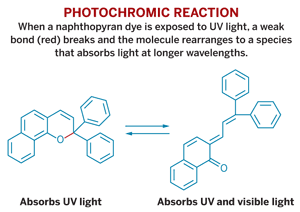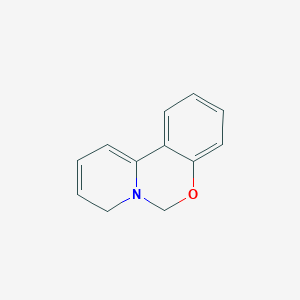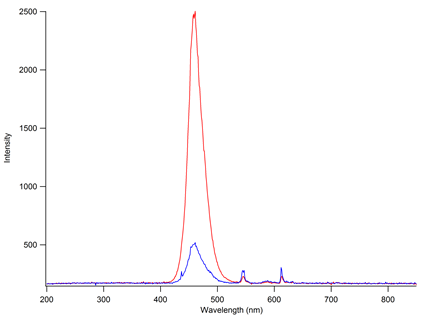Photochromic Lenses
By Selene Hounsve
Photochromic lenses are clear indoors and darken when exposed to sunlight. The first photochromic lenses were made of glass in the 1960s and glass photochromic lenses contain silver halide crystals embedded in a glass substrate. In the presence of UV light (320-400 nm), electrons from the glass combines with the colorless silver cations to form elemental silver. Elemental silver is visible which we see when the lenses darken. In absent of UV rays, the reaction is reversed. The silver returns to its original ionic state, and the lenses become clear.
Glass photochromic lenses are still manufactured but are less popular than plastic photochromic lenses. The plastic photochromic lenses are completely different from the glass lenses. The first generation of plastic lenses were made of a family of organic dyes known as blue pyridobenzoxazines. Subsequent generations used naphthopyrans, and today lenses are made with indenonaphthopyrans. When a photochromic dye is exposed to UV radiation, a chemical bond is broken. The molecules then rearranges into a specific species that absorbs at longer wavelengths in the visible region, causing lenses to darken.
Improvements in the dyes over the years have led to faster activation and clearing, as well as longer lifetimes. For example, fusion of a bicyclic hydrocarbon group, called an indene group, to one of the benzene rings in a naphthopyran dye to make indenonaphthopyrans helps protect the dye from breaking down over time. The lenses material is important to support the layer of photochromic dyes, which affects how fast the lens darken and fades. Photochromic dyes do not work well in common plastic lenses, so companies developed special monomers that are compatible with the dyes.
Thinner plastic lens materials used for strong prescriptions, such as polycarbonate and thiourea, are also not readily amenable to the photochromic dyes. For example, thioureas can attack the photochromic dyes, breaking them down fairly quickly. To get around those issues, Transitions has developed a process in which the photochromic dyes are sandwiched between multiple coatings of polyurethane on the surface of polycarbonate and thiourea lenses.
Glass photochromic lenses offer better resistance to scratches and can faithfully switch between dark or clear for longer than their plastic lens counterparts. This is because glass lenses employ durable inorganic silver, whereas plastic lenses employ less robust organic dye molecules.



